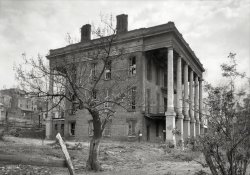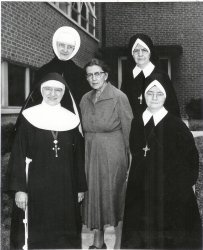
MAY CONTAIN NUTS

Search Shorpy
SHORPY ART

Framed or unframed, desk size to sofa size, printed by us in Arizona and Alabama since 2007. Explore now.
Join and Share
Ad-Free Shorpy
Shorpy is funded by you. Patreon contributors get an ad-free experience.
Learn more.

Recent comments
- Details, Details
- What's that building to the left of the tower?
- Coal Barges
- Bromo-Seltzer
- Inner harbor
- The Basin
- What a headache!
- Giant stepladder?
- Baldwin 62303
- Baldwin VO-1000
- Cold
- No expense spared
- Tough Guys
- Lost in Toyland
- And without gloves
- If I were a blindfolded time traveler
- Smoke Consumer Also Cooks
- Oh that stove!
- Possibly still there?
- What?!?
- $100 Reward
- Freeze Frame
- Texas Flyer wanted
- Just a Year Too Soon
- WWII -- Replacing men with women at the railroad crossing.
- Yes, Icing
- You kids drive me nuts!
- NOT An Easy Job
- I wonder
- Just add window boxes
Member Photos
The Shorpy
Print Emporium
Print Emporium
Search Shorpy
Search results -- 30 results per page
- Brown and Gray: 1906
- Providence, Rhode Island, circa 1906. "Front campus, Brown University." 8x10 ... in the classic gas light style.
(The Gallery, DPC, Providence) ... Posted by Dave - 07/29/2012 - 6:15pm -
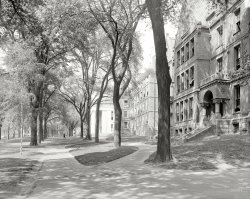
- The Wolverine: 1922
- ... food chain? There was also one by that name in downtown Providence. I don't know when it opened there, but I do know that it lasted ... Posted by Dave - 08/18/2012 - 5:52pm -
![The Wolverine: 1922 Washington, D.C., circa 1922. "Leader Theater, front." Sidney Lust's movie house on Ninth Street N.W. National Photo Company glass negative. View full size.
Into the MixWow. Interesting mix of dancehall cafe, Greek restaurant, vaudeville/burlesque house and cinema. Even in black-and-white, certainly more colorful than the mall multiplex.
Breathtaking ArchitecturePlease tell me this magnificent building is still standing. Built in 1910, it could be . . .please!
The gigantic statuary flanking the marquee---dwarfed by the HUGE roofline finial statues---is simply stunning. All the buildings along this block have unique architecture with intricate detail. Was this an "entertainment block"? I see a cafe/dance hall, burlesque house, the Leader theater, and a Greek restaurant. I wager to say even the "Washington Shoe Shine and Hat Cleaning Parlor" was probably an entertaining place to visit!
The Tarzan die cut advertising tucked around the marquee would be worth a small fortune on today's antique market!
The Port ArthurStarting from the left...
Washington Post, Oct 20, 1914
Fight in Chinese Cafe
Three Men Arrested Following Row in
Port Arthur Restaurant
The moving-picture district on Ninth, between E and F streets northwest, was thrown into a state of excitement last night just as the shows were discharging their crowds by a fight in the Port Arthur Chinese restaurant, in which three young men are alleged to have attempted to smash everything in the shape of furnishings and the head of every Chinese employee in the place.
The trouble attracted a crowd that blockaded the street from curb to curb. Cries and curses and the breaking of glass and tableware added to the situation.
Policeman Miller alone grappled with the fighters and emerged from the place brining three of the principles with him. They were taken to the first precinct.
Morris Sing, proprieteor of the restaurant, told the police that the party came into his place and ordered food. Then for some reason unknown one of the men picked up the dishes, smashed them, and then started a general assault principally against the Chinese employes of the place.
Several of the Chinese waiters were injured, but refused hospital treatment.
A one-sex audienceAll boys, I notice. Apparently girls stayed home on Saturday afternoons. All in knickers, scratchy woolen stockings and high leather shoes. And every single one of them wearing a cap except the half-dozen or so who are holding them in their hands.
Helen Gibson in "The Wolverine." Not much information, I'm afraid.
Elmo Lincoln in "The Adventures of Tarzan." (Lots.)
The WolverineI had no idea Hugh Jackman was so old!
"The Wolverine"Plot Synopsis by Hans J. Wollstein
Based on a novel by the prolific B.M. Bower (pseudonym for novelist Bertha "Muzzy" Sinclair), The Wolverine starred former serial queen and stunt-woman Helen Gibson as a rancher who stands up for an employee (Jack Connolly) unjustly accused of cattle rustling. Ward Warren (Connolly) had come West after serving a prison sentence for a crime he didn't commit. History repeats itself for Ward when a couple of bandits he had chased off the land, accuses him of being a rustler himself. The former common-law wife of Hoot Gibson, Gibson (née Rose Wenger) had gained stardom replacing Helen Holmes in the long-running The Hazards of Helen. By no means a traditional screen beauty -- but spirited -- Gibson's starring career was brief, and she returned to stunt-doubling in talkies.
http://www.allmovie.com/work/wolverine-117381
Around the World in a BlockThe architectural walking tour here is pretty wild. There's the Belle Epoque excesses of the Gayety and Leader theaters, crowned by their zinc copies of sculptures from the Petit Palais at the Exposition Universelle in Paris. Then there's the Gothic church facade of the Port Arthur Restaurant. And then there's the Acropolis (Greek) restaurant housed behind a Chinese balcony, left over from the Port Arthur's old location on the other side of the Gayety (the stairwell entrance to the "gothic" Port Arthur at 515-17 has a matching Chinese carved wood awning). But just when I was getting an urge for some nice spanakopita, I noticed that the Acropolis seems to have been replaced by the all-American Rowland's Buffet.
Cable cars?Is that a cable slot between the streetcar tracks?
[It's access to the underground electrical supply that powered Washington's streetcars. - Dave]
"Fastest Northwestern Picture Ever Screened"What the heck does that mean?
["The Wolverine" was a train. Which is shown in the sign. - Dave]
Coming AttractionView Larger Map
The location today. The J. Edgar Hoover Building is right behind you.
The GayetyThis is right around the corner from the original 9:30 Club. I remember parking across the street from the Gayety in the early 80's. Creepy place, they showed "adult" movies. Lots of drug addicts and perverts.
Wilbur Mills and the GayetyThe Gayety lasted into the 1970s. That's where House Ways and Means Chairman Wilbur Mills first met "Argentine Firecracker" Fanne Fox, who later jumped from his car into the Tidal Basin and sank Mill's career.
Gorgeous photograph!And also a revelation for me. Was The Port Arthur a Chinese food chain? There was also one by that name in downtown Providence. I don't know when it opened there, but I do know that it lasted well into the 1940's and was - according to my Dad - the hottest place to go to on a Saturday night in the late 30's and early 40's. Drinking, dancing to a band and exotic, for its time, Chinese food.
My Aunt Mary and another female relative sang there, as well.
What an eye-opener! And what a thrill this photo is to drink in! I'd throw down my nickel to see that movie in a second - if only for the pleasure of getting to see what the inside of the theater looked like!
This is one of the very best postings this year.
[Below: The Port Arthur Chinese restaurant in New York. Click to enlarge. - Dave]
Helen GibsonThat picture is awesome. Thanks for sharing it. I have been researching Helen Gibson for many years and have many of her personal ephemera pieces. Including her copy of the Wolverine lobby card with the image enlarged as a poster on the left of the entrance. Thanks for your site, I always see something exciting.
Newsboy MatineeGiven all the young boys and the fact that that whatever is going on here it merited a photograph, I am guessing this is another gathering of newsboys for a Saturday matinee. Shorpy viewers have previously seen a similar event in this 1925 photo of the Leader Theater. Alas, no sign of Bo-Bo, "the monkey with the human brain," in the photo.
Washington Post, Feb 12, 1922
Carriers' Theater Party
Many Post newsboys yesterday had the time of their lives at the showings of the latest installment of the Adventures of Tarzan at Sidney B. Lust's Leader and Truxton theaters as the guests of Mr. Lust and the circulation department of the Post. The boys found the day an even greater event than they had expected, for in the morning at their homes, each had received letters from W.C. Shelton, circulation manager of The Post, thanking them for their efforts delivering The Post on time during the storm and enclosing $1 as a bonus.
Mr. Lust, who was host to a number of the carriers yesterday, will entertain as many more today, for tickets good for either day were sent out. As a special inducement to efficient service, the boys who rank among the best carriers in the city will receive free movie tickets for the next 15 weeks.
The boys had been particularly interested in the Tarzan film, which features Elmo Lincoln. Bo-Bo, the monkey with the human brain, was on hand to meet the boys when they reached the Theater, and on leaving every boy was given a bag of peanuts. Bo-Bo plays an important part in the Tarzan serial, and his antics created much amusement.
Elmo!Where else but in America could a guy named Elmo with a 52-inch chest become a movie star? In addition to his rightful claim to fame as the first film Tarzan (in 1918), Elmo Lincoln was also in the silent classics "Birth of a Nation," "Intolerance" and "That Fatal Glass of Beer." He came back in the late 1930s in bit roles in talkies, including "The Hunchback of Notre Dame."
"The Adventures of Tarzan" was Lincoln's third and final foray in the role of the vine-swinger, which was probably just as well, as he was afraid of heights. Released as a 15-part serial, it was one of the smash hits of the year, taking in more than Valentino's "The Sheik."
Sugar Plums at the GayetyWhen this photo was taken, burlesque had not yet begun its long slide from musical comedies and revues into adults-only sleaze. The Washington Gayety was one in a large chain of theaters, with shows rotating among them on a circuit, as in vaudeville. Gayety shows featured such stars as Al Jolson, Fanny Brice, Sophie Tucker and Will Rogers. Harry Coleman, starring in the Washington Gayety's "Sugar Plums," was a comedian who began receiving favorable reviews around 1915, and appeared in a few silent films as early as 1910 (his last film credit is as a bit player in the dance hall scenes in Chaplin's "The Gold Rush"). On Nov. 8, 1918, the Toronto World ran a notice for the Toronto Gayety's new show "The Roseland Girls," beginning with this lead:
"The Roseland Girls" is a show that may always be relied upon to furnish the sort of entertainment that the patrons of the Gayety Theatre will like and will be enjoyed by all classes of theatregoers. The company is headed by Harry Coleman, Bert Lahr, Kitty Mitchell" [and others].
Absolutely wonderful. What a civilization we once had!
The adult on the far right appears to be halting traffic with his blurry arms so as to give the photog a clear view of the newsboys.
Elmo of the ApesElmo Lincoln was in the first Tarzan feature, "Tarzan of the Apes," which was filmed in Morgan City, La. (I suppose if you took the Southern Pacific east out of LA that would be the first quasi-jungle swamp you would come to.)
Morgan City is a real pit, an oilfield blue collar town with not much going for it. In 1986 I was staying overnight there and read in some chamber of commerce brochure an invitation to come back in 1988, for the 70th anniversary of the release of the film and Morgan City's Tarzan fest.
Two years later the Wall St. Journal had an article in its humorous-story corner about how in the midst of all the planning the Edgar Rice Burroughs estate prevented Morgan City from going forward with the festival. The poor town was stuck with all of the preliminary costs of their big event in the city's history. What a shame.
Good thing there was a captionI couldn't see the name of the theatre anywhere on it. I suppose it could be covered by a banner for the movie. You'd never see a business today allowing its identity to be obscured.
Elmo Is My HomeboyElmo Lincoln is the only movie star from my hometown of Rochester, Indiana! That's all I've got to say. Some 4-digit population towns can't claim ANY movie stars.
What is next door?Does anyone read Greek? I wonder what the upstairs of the building on the theater's left houses?
[The name is there in both Greek and English: Acropolis Cafe. - Dave]
Dressed to the NinesI can't imagine a group of that many boys wearing ties to a movie today.
(The Gallery, D.C., Movies, Natl Photo)](https://www.shorpy.com/files/images/30200u.thumbnail.jpg)
- The Bowery: 1900
- ... Nixon's research has shown that all the horses in Providence, R.I. polluted Narraganset Bay with enormous amounts of nitrogen ... Posted by Dave - 08/01/2012 - 5:36pm -
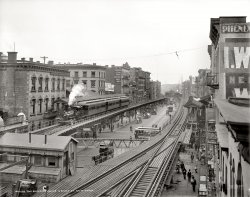
- Seasonal Greens: 1940
- ... December 1940. "Christmas trees for sale at the market. Providence, Rhode Island." Medium format negative by Jack Delano. View full ... 1896.
(The Gallery, Christmas, Factories, Jack Delano, Providence) ... Posted by Dave - 12/03/2018 - 11:20am -
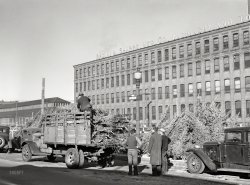
- Cat House: 1935
- ... down in 1977 or 1978 to make a strip mall shopping center (Providence Square, at the corner of Kempsville and Providence Roads, directly across from its twin, Fairfield Shopping Center). I ... Posted by Dave - 02/05/2014 - 11:01pm -
![Cat House: 1935 Circa 1935. "Reuben Lovett house, Princess Anne County, Virginia. Structure dates to 1790." 8x10 negative by Frances Benjamin Johnston. View full size.
Traces of EleganceThough it's lost its portico and tablature, this house still reflects its original upscale aspirations: three (or probably four) chimneys, a relative wealth of windows, etc.
Clearly still inhabited, or else that is the most patient cat in the Old Dominion. [Two cats, actually. - Dave]
One interesting detail is the pair of brackets awaiting reinstallation of the window box. Another, more troubling to the rehabilitator, is the obvious knob-and-post wiring job.
Kiddie CarWhat is this? It looks like a toy car of some sort, it has a license plate and the stylized logo seems vaguely familiar.
I grew up near this place. (Kempsville)But if it's the building I think it is, it was torn down in 1977 or 1978 to make a strip mall shopping center (Providence Square, at the corner of Kempsville and Providence Roads, directly across from its twin, Fairfield Shopping Center). I remember the house having just an incredibly beautiful, large oak tree in the front yard, and the most beautiful staircase structures I had ever seen when they tore the front of the building off (three days to take it down; they went slow). If you check Google Maps, it has the entrance to the shopping center listed as Profair Way; the house was facing Providence Road and Profair Way was basically where the original drive to the house was, with the house just slightly south of the P but before the center itself. This picture would have been taken slightly north of due east, which the shadows agree with if this was an morning in the early winter time frame. Providence Road would be off to the right from the picture, and Kempsville Road (modern Kempsville Road, at least) would be behind the photographer.
If it's the same building (and I lived in the area as it was built up to become a pretty dense suburbia), it had obviously been repaired and lived in until about a decade earlier or even the early 1970s, but it had fallen into disrepair again by it's destruction.
I've often thought about how old that building looked, and how old it must have been when they tore it down.
The entire area, of course, is now part of the City of Virginia Beach (all of Princess Anne County became part of Virginia Beach back in the early 1960s), but this is the Kempsville area of the city.
I'm so sorry, Dave, that I can't report it as having been on Pleasure House Road; that's on the opposite side of Virginia Beach.
Kiddie carYes! I noticed that too. Mack truck. Think it's a pedal car? I grew up with "cars" however my little brother had a fire truck in the early '70s.
That's an early Mack Truck logoKiddie Division.
A Bulldog, to be preciseAn earlier post of mine was too obscure to make the cut, but that pedal car was modeled after the Mack AC introduced in 1916. The Mack AP, produced between 1926 and 1938, was similar—but larger. The 1915 AC prototype is seen below.
Steelcraft made various pedal car versions of the Mack AC, including this one, which closely matches the one in the yard:
(The Gallery, Cats, F.B. Johnston)](https://www.shorpy.com/files/images/SHORPY_05503a.thumbnail.jpg)
- Brooklyn Bridge: 1905
- ... was a passenger and freight steamer that ran aground up in Providence in 1901.
... Posted by Dave - 07/31/2012 - 2:53pm -
![Brooklyn Bridge: 1905 New York circa 1905. "Brooklyn Bridge over East River." 8x10 inch dry plate glass negative, Detroit Publishing Company. View full size.
Chester W, ChapinThis steamer was named for Chester W. Chapin (December 16, 1798 – June 10, 1883), U.S. Representative from Massachusetts (March 4, 1875-March 3, 1877). The ship was of the twin-screw type, 312 feet in length, 64 feet wide, with a tonnage of 1,882. It was built by the Maryland Steel Company of Sparrow's Point, Maryland, for the New Haven Steamboat Company in 1899.
NoticeThe piles of ballast stones near the bottom of the photo, as well as the railcar float to the left of Pier 20.
Nice Looking BridgeIs it for sale?
Wow. I can almost smell it, man. Nice job once again.
Fab Photo!What a great photo! I love to visit New York, and every time I do, I go to Brooklyn and I walk across the Brooklyn Bridge to Manhattan. I am always amazed at t his amazing structure and this is a wonderful photo!
Roll Out The Barrell(s)Nice photo. The "Chester W. Chapin" looks like a nice craft to take a ride up L. I. Sound on. It's rare to see a staved barrell these days. There sure are a lot piled up there on the dock.
[Evidently they were full of L's. - Dave]
Style!What a beautiful, elegant looking boat!
Boat RideIt looks like it could be a very pleasant boat ride up the Sound to New Haven or Bridgeport.
New?What an immaculate-looking ship is the "Chester W. Chapin!" Quick, let's invent the term "shipshape."
Uh-OhThe Chester W. Chapin was a passenger and freight steamer that ran aground up in Providence in 1901.
http://query.nytimes.com/gst/abstract.html?res=9403E2D61330E132A25756C0A...
High tideThere appears to be a high water mark on the sides of this building.
(The Gallery, Boats & Bridges, DPC, NYC)](https://www.shorpy.com/files/images/4a12689a.thumbnail.jpg)
- Mourning McKinley: 1901
- ... white building in the upper right as being the “old” Providence Hospital located at the time at 2nd & D Streets SE on Capitol ... The buildings in the photo were razed and site became Providence Park, which still exists today. Incidentally, a number of previously ... Posted by Dave - 02/03/2021 - 10:29am -
![Mourning McKinley: 1901 Washington, D.C. "View from Randall School of H Street S.W., between Half & First Streets, in 1901 showing coal yard and old homes near railroad station. Houses have McKinley memorials. Portrait of President William McKinley draped in black is visible on the house on the left. A flag is at half mast on the right." Along with at least two other McKinley portraits. 8x10 inch glass negative, D.C. Street Survey Collection. View full size.
Oddly lonelySuch a stark contrast exists between the pretty house with delicate embellishments casting lacy shadows -- the two older folk porch sitting on an early autumn afternoon; the younger woman dressed like an Old West frontier female standing by, arms crossed; the hatted child playing at the edge of the sidewalk -- and the rest of the landscape, which appears suspended in a dusty, lonely languor.
McKinley's destinyThe assassination of William McKinley made Theodore Roosevelt President at the age of 42. When TR became Vice President earlier that same year, his friend Charles G. Washburn remarked: "I would not like to be in McKinley's shoes. He has a man of destiny behind him."
Buffalo / DallasI was 7 when President Kennedy died. I never hear mention of Dallas without thinking of his assassination. I've always wondered, did people who were alive when McKinley died have similar associations with Buffalo, where he was assassinated?
TRElsewhere in the city, "that damned cowboy" Teddy Roosevelt has just become the new President.
All the houses with TepeesI had always assumed that the little turrets, or cones on the corners of houses were purely for appearance. I wonder whether they also played a structural purpose since more than two dozen of them are visible in the picture.
McKinley's DeathWhen he died President McKinley was widely and deeply mourned. The trappings of official and Victorian mourning with black crape and formal mourning attire were everywhere. But so also were touching demonstrations by simple people throughout the country where public assemblies and special services in churches were held. The route of his funeral train was lined by ordinary working class people standing shoulder to shoulder with the well off and powerful. People placed coins and flowers on the train tracks and kept the flattened remnants as mementos. At almost every stage of the journey local bands appeared playing the hymn "Nearer My God to Thee," a popular hymn and Mr. McKinley's favorite long before it became associated with the Titanic disaster. McKinley was a deeply religious man and according to popular legend (disputed) his last words were from the opening verse of the hymn.
Here is a link to some rare film footage of the official ceremonies and funeral procession. https://youtu.be/gTQrpsZ3tQA
LOCIs that the Library of Congress in the distance on the left?
Ballast = coalI believe we're looking at a coal dealer. Note that some of the bays are divided so the coal can be sorted as to lump size and possibly some choice Anthracite in there.
Seems to be a small cart-ramp extending over yet more bays below.
Displaying FlagsFlags are flown at half mast aboard ships. On land they are flown at half staff.
Jefferson BuildingThe partially visible large building in the upper left of the image is southeast corner of the Jefferson Building of the Library of Congress, which was completed four years before the image was taken.
Lehigh ValleyThe elevated rail arrangement and piles of ballast in the center-right of the photo remind me of all the comments and speculations last week with regard to Earth Movers: 1901.
Building IDI'm curious about the complex of large white (at least in this picture) buildings in the upper right. Can we identify that?
It's on the MapGoats of Venus has indeed got it right. [As does the photo caption, which calls it a coal yard - Dave] A look at a 1904 Sanborn Fire Insurance map shows this to be the Allegheny Coal Co. The map clearly shows the hard and soft coal trestles as well as the other structures on the site. Even more fascinating, it matches up perfectly with the houses in the image (facing H Street) and accurately shows their construction, with the pink color representing brick and yellow being frame. Even the 2-story frame porch on the house in the foreground is shown on the map as well as the split brick and frame construction of the first house around the corner on Half Street.
Building ID FoundAfter much sleuthing, including trying to get the right perspective using old DC maps, I can positively identify the large white building in the upper right as being the “old” Providence Hospital located at the time at 2nd & D Streets SE on Capitol Hill (see the image in the plaque below).
I’m a bit embarrassed it took me so long to figure it out--I was born there in 1950. Dating to the Civil War era, the hospital moved in the 1950s to larger quarters in Northeast. The buildings in the photo were razed and site became Providence Park, which still exists today. Incidentally, a number of previously published Shorpy photos were taken around the same time frame from the roof of the hospital, including several pointed back in the general direction of the Randall School—the reverse of where we’re looking from in the photo above.
The fall of a sparrowThe prominent group of structures at 2 o'clock is the old Providence Hospital complex. It's a park now.
(The Gallery, D.C., D.C. Street Survey, Railroads)](https://www.shorpy.com/files/images/SHORPY-40417a.thumbnail.jpg)
- Sootyscape: 1904
- ... East, while the ramp to the left was to be used for all Providence, Franklin, Needham, Dedham, and Stoughton lines. From what I read, ... replaced by South Station: Old Colony RR, Boston & Providence RR, Boston & Albany RR, and the New York & New England RR. ... Posted by Dave - 08/05/2012 - 6:23pm -
![Sootyscape: 1904 Boston, Massachusetts, circa 1904. "Yard and tracks, South Terminal Station." 8x10 inch glass negative, Detroit Publishing Company. View full size.
Rough (rail)road aheadIf you ask me, that switched diamond junction in the lower-right looks a bit treacherous. Maybe if you get up enough speed and Evel Knievel it to the next track...
NiceReally love the geometry of the tracks. I pass through this station every day on my way to the office in downtown Boston.
What a mess of double slip switches that is! Those switches are double slip,meaning that each one handles the duties of two normal switches.
Puzzle SwitchesThese are "double slip" or "puzzle" switches. They combine four switches and a diamond crossing in only slightly more track length than a single switch or crossing. Very common at big passenger stations, due to the tremendous space saving, but hard to maintain, thus very rare outside that context.
I hand built one in HO some years ago, doubt that I will ever build another. I count 28 of them in the picture, plus many conventional switches.
Handling all those switches isn't that stressful, since there is a mechanical interlocking frame in the tower to prevent lining up conflicting routes, and the switches are thrown pneumatically. There is a large track diagram in the tower, with every switch and signal numbered, to use as a guide. However, keeping trains moving in and out efficiently is highly skilled work, little different from air traffic control. These tower operators would "have a lot of whiskers," or high seniority.
It appears that at lower right, the ramp track to the lower level was in the process of being abandoned, I vaguely remember reading references to that, apparently the lower level platforms didn't work out as planned. There is also evidence of some track rearrangement in the form of extended ties and switch machine parts at lower center, just beyond Signal Bridge 8.
Regarding the cars at the left, passenger trains were the airliners of the day, and carried much more than passengers - mail, express parcels (Railway Express and its competitors, the FedEx of the era), and perishables. In many metro area commuter zones, including Boston, milk was carried from farm to the city in special refrigerator cars cut into passenger trains.
Switches!Being in charge of switching all those rails correctly, every time, must have been one heckuva stressful job.
And probably sold a lot of headche powder and Bromo Seltzer, too.
Mail?I'm curious what those railcars on the left would be used for.
South StationWonderful photo of a building that still exists. You can see the back of the clock and eagle which stand above the front of this station. The station has been remodeled, fortunately the facade of the building was preserved, the interior has been changed. Progress, some people say.
Attention model railroadersBet you can't model that switchwork.
The Big SootyThe filth (and smelliness) of cities at the time when coal was widely used for heating and, as here, railroading would astonish people today.
Many buildings in Milwaukee were built in the 19th century from a local clay that's light tan in color -- "cream city brick." But they didn't stay cream-colored for long, thanks to the coal soot belching out of every chimney.
Downtown still has many of these brick buildings, and while many of the more prominent ones have been scrubbed back to their original color, lots of others -— the less important ones, and those on side streets — still have the blackish patina they acquired before about 1960.
South StationSouth Station is only 9 years old in this photo. All 28 tracks are in use, and at this time it is the busiest passenger terminal in the world. It was capable of handling 8 simultaneous train movements through the yard throat.
This picture most likely was taken from the drawbridge control cabin over the Fort Point Channel. This 3-bridge, 6-track structure was only torn down in the past 10 years or so for the Big Dig.
The large train shed was torn down in the 1930's due to the expense of maintaining it and the corrosive effects of the coal smoke on the steel and concrete structure. Not to mention keeping the glass clean.
The building on the left is the outbound express building, which was originally used by a predecessor of the Railway Express Agency. Most if not all the cars in the photo are wood framed cars. The 3 cars behind the leg of the tower are especially ancient with their flat arched roofs.
The building on the far right is the power plant and gas plant for power and lighting of the station (replaced by the South Postal Annex in the 1940's). The coal carrying cars are of the drop bottom gondola type, rather than a true hopper car. The reporting marks on that old tank car is "W.O.W.", and I have no idea what railroad or shipper that is.
The two ramps on the right lead to the abandoned underground commuter loop. This was to be used with electric commuter cars like the ones used on the Nantasket Beach Branch of the New Haven Railroad. This was center 3rd rail, like Lionel toy trains. Safety complaints and projected expense kept the New Haven from electrifying all Boston commuter traffic like it wanted to. South Station was the 1st terminal in the world to be designed for electric trains, and yet it didn't happen until the 1990's for Amtrak on the upper level. The reason for two ramps is that the one on the right was to be used for all Old Colony RR lines to the South and East, while the ramp to the left was to be used for all Providence, Franklin, Needham, Dedham, and Stoughton lines. From what I read, they tried to use the loop once with a steam engine test train, but almost killed everyone on board due to the total lack of ventilation.
The loop station was used at various times as a parking garage and a bowling alley. It was not fully removed until South Station's reconstruction in the mid-1980's.
The Atlantic Street wing of the station (visible at left) was torn down before preservation efforts started. It was rebuilt much wider in the 1980's for a food court. They reopened the same quarries used in the 1890's to get the same color granite. The Summer St. wing was shortened by half for the Stone & Webster tower.
All of South Station was owned by the Boston Terminal Co., which was jointly owned by the railroads that had their own stations replaced by South Station: Old Colony RR, Boston & Providence RR, Boston & Albany RR, and the New York & New England RR. Each RR owned 20% of the BTCo., plus the New Haven RR which owned the OCRR, NY&NE, and B&P (giving the NHRR 80 percent control).
Today, South Station is at 13 tracks, yet it has more scheduled trains than in 1940. There is serious talk of moving the Post Office out, and expanding the track diagram to 20 tracks.
W.O.W. - The Company Became Part of ValvolineThe W.O.W. marking on the tank car stands for the Wilburine Oil Works, Ltd. which was essentially a subsidiary of Valvoline Oil Company (97.04% of stock was owned by Valvoline by 1898).
A predecessor company of the American Association of Railroads (AAR) later assigned the "WOWX" mark to Wilburine rail equipment and they used this mark during the period 8/1920 - 7/1923.
Valvoline Oil Co. used the "WOWX" mark after 7/1930.
Car number 225 shown here is listed amongst Wilburine's holdings in the Official Railway Equipment Register for September 1901. In fact, the next car number, car 226, is the highest number shown.
Originally an abbreviated company name alone was used to designate the owning company of a railroad car. With the growth of international and transcontinental shipping a standardized naming convention was introduced. Most companies retained their old abbreviations, but suffixes were added to differentiate various type of shipping equipment. The letter "X" designates a commercial railcar.
Sometime after 1911 but definitely by 1917 Valvoline was using the VOWX (Valvoline Oil Works, Ltd.) mark and Wilburine was using the WOWX mark.
The W.O.W. car sitting in the yard makes sense because steam trains needed lubrication for their valve gear(s). Valvoline was a principle supplier of this type of oil for more than 70 years.
Valvoline was founded in 1866 as the Continuous Oil Refining Company by Dr. John Ellis. The name “Valvoline” was established in 1868 (VALVe OIL [for the] LINE) and it was trademarked in 1873. Valvoline Oil Works and Wilburine Oil Works finally merged in 1925 according to Moody’s' Industrial Manual (1929 edition, Volume 1).
Is That Fire?!Is that fire shooting out from the chimney of the tall building on the far left, or is it just the result of a deteriorated negative? If it's fire, there must be a lot more going on inside the building that can't be seen.
(The Gallery, Boston, DPC, Railroads)](https://www.shorpy.com/files/images/4a11368a.thumbnail.jpg)
- Momma's Marine: 1916
- ... was wrecked. Gordon, who piloted the plane, was taken to Providence hospital, where , it was said last night, he has a good chance for ... Posted by Dave - 08/28/2012 - 9:10pm -
![Momma's Marine: 1916 Washington, D.C., circa 1916. "Mrs. George Barnett and son." Lelia Gordon Barnett, wife of the Marine Corps commandant, and her son Basil Gordon, who in 1923 became the first person to crash an airplane in the District of Columbia. Harris & Ewing Collection glass negative. View full size.
What an honor!Did he survive?
[He did, but his passenger, 21-year-old Edwin Trusheim, was not so lucky. "Goodbye, old man, it's all over," were the pilot's parting words. - Dave]
Last Flight of The Elaine
Washington Post, Dec. 10, 1923
Passenger Killed,
Basil Gordon Hurt
As Plane Crashes
Edwin Trusheim, 21 years old, of 210 B street southeast, was killed, and Basil Gordon, 29, stepson of Maj. Gen. George Barnett, was seriously injured when the airplane in which they were riding crashed to the ground on a vacant lot at Half and L streets southwest shortly after 4 o'clock yesterday afternoon.
Trusheim, a passenger in the machine, which is owned by Gordon, was killed almost instantly, being crushed under the heavy motor as the craft was wrecked. Gordon, who piloted the plane, was taken to Providence hospital, where , it was said last night, he has a good chance for recovery, despite the seriousness of his injuries.
Yesterday's accident is the first time in history that an airplane has fallen within the city limits of the Capital, despite the great amount of flying which has been done in the vicinity during and since the war.
According to witnesses, the plane was about 2,000 feet in the air when it began to flutter. As it neared the ground, and when at a height of about 700 feet, it went into a nose spin, and struck the ground first with its propeller, the heavy motor being pushed onto Trusheim, who was riding in the front seat.
…
So far as could be determined, the wings and struts were in good condition, and the theory was advanced that the cause of the trouble must have been in the motor. Failure of the motor at the height at which the plane was flying would have made it impossible to right it before hitting the ground, it was said.
…
Gordon tested his plane, and then he and Law climbed into it and took off. For fifteen minutes they circled over the field, and made a short trip over the city.
"The machine ran very smoothly," Law said last night. "Though I had never been up before, I had the greatest confidence in Basil's ability to control the plane, for he has quite a reputation as an expert aviator. During the flight we talked about how well the machine was running, and what a beautiful view of the city we had. We made a perfect landing."
After Gordon returned with Law, Trusheim said that we would like to make a flight, and a few minutes later "The Elaine," as Gordon had christened the plane, took off on her last trip.
For a few minutes the plane flew swift and straight over toward the city. Then to the little group of relatives standing at the flying field, it was seen to hesitate, to shiver, and then, with a quick, whirling motion, descend.
With realization that something had happened, Mrs. Gordon and Miss Gordon, with Law, jumped into a motor car and started for the city. It was nearly an hour before they could locate the scene of the wreck in the little hollow south of the Capitol. And by they time they arrived on the scene the victims had been removed.
Will fight for foodLooks like Momma didn't feed her Basil quite enough. That is one skinny soldier.
Like Mother Like SonI can see where he got his good looks - from his mom. Such a proud mother. Ooo-rah!
Riding BreechesThe riding pants indicate that this guy was one of the Horse Marines. And, yes, they did exist.
Focus, focus, focusWhy are the buckles on his boots and the buttons above them in perfect focus, yet the rest of the photo is a bit softly focused?
[The shoes didn't move. - Dave]
Wally and BasilMrs. Barnett was first cousin to the mother of Wallis Warfield, the future Duchess of Windsor. She and her son showed amusingly understated enthusiasm in 1936 when King Edward abdicated and announced his intention to marry Mrs. Simpson. Basil is quoted as saying, "I haven't seen Wally for six years. She seems to be going places."
How thymes changeCan you imagine any modern-day Marine Corps commandant naming his son Basil? He must have grown to become quite a sage.
[Yes, he'd be mustard right out of the military. But the General had no input into Basil's name -- he was his stepfather; Basil was named after his father. - Dave]
Mrs. CommandantPolitically, Mrs. Barnett was a force to behold in WWI Washington. Secretary of the Navy Josephus Daniels crossed her when he tried to install his favorite marine (John Lejeune) as commandant of the Marines, in place of her husband. After Daniels asked his most senior officers for resignations (effective at the end of the war) and received them from all but Barnett, he blamed Mrs. Barnett, quipping that Barnett's Indian name would have been "'the-man-who-is-afraid-of-his-wife.'" When Daniels ordered the change, Mrs. Barnett worked through the crippled president's personal physician and her allies on Capitol Hill in an unsuccessful bid to countermand it. Her son Basil, said to be one of the most undisciplined members of the Corps, asked her to help get him released when he was confined to quarters. It did not succeed.
BreechesSomebody called this marine a soldier in a previous post. Marines don’t like that.
Anyway I respectfully disagree about the breeches. Although horse marines did exist, I believe riding breeches were de rigueur for all officers back in 1916. This young man appears to be a lieutenant.
Shape Up or Ship OutGawd, a Marine without a spit shine on his Class A uniform boots. Horrors!
Not the first crashActually, the first aircraft crash in DC proper was on September 17, 1908. On the date mentioned, Orville and Wilbur Wright were demonstrating their machine for the Army at Fort Myer (also where Arlington Cemetery is), and Lt. Thomas Selfridge volunteered to be a passenger ...
[Fort Myer isn't in D.C. -- it's in Arlington County, Virginia. - Dave]
A Very Handsome ChapHe is one good looking young man. Must have been terrible to crash and mortally injure a friend. On a happier note I adore his mom's shoes.
Commandant BarnettMy dad was in Marine training in 1917. Here is an excerpt from one of his letters dated August 5, 1917, Marine Barracks, Port Royal, South Carolina:
I got to see Brigadier-General Barnett, the head of the Marine Corps, a while back. He was inspecting the training camp on this island and we were drawn up in two lines while he passed between them.
I will save this picture and put it into his album just for additional background to his military history. Thanks Dave.
Mum's remarriageWhat a charming photo. Enjoying all the comments here, too.
Here's the announcement of his mother's remarriage to Lt. Col. George Barnett in 1907.
They met at a supper dance on Dec. 9, 1906, and he immediately began wooing her. In fact, he was said to have "pursued her as if he was assaulting a military objective," according to "Commandants of the Marine Corps." They finally wed on Jan. 11, 1908. Barnett was later the 12th Commandant of the US Marine Corp., ousted by some guy named Lejeune in 1920 (joke) and died in 1930.
I've found shockingly less on the Marine in the photo, though he served in the Great War and was still stationed in France for a while thereafter. The elder Basil Gordon, who had wed his mother in 1892, died in 1902, leaving her with four young children.
(The Gallery, D.C., Harris + Ewing, Portraits)](https://www.shorpy.com/files/images/17747a.thumbnail.jpg)
- Hollywood Family: 1965
- ... saw The (original) Rolling Stones when they came through Providence, touring on "Get Off Of My Cloud." I think the tickets were $2.50, ... Posted by tterrace - 09/29/2011 - 7:14pm -
![Hollywood Family: 1965 November 1965. Fabulous, glamorous, glittering, world-famous Hollywood & Vine. My mother, father and brother take in the dazzling sights while I snap off this Kodachrome, two years after my previous memorable visit. Looks like brother and I have been hitting the record shops. Notable vehicles include a shiny red pre-1957 Volkswagen beetle, a 1961 or 1962 Thunderbird, a 1958 Plymouth wagon and, most interesting of all, a City of L.A. Water & Power Studebaker Champ pickup. View full size.
Then and NowIn South Central, Drug King is now Drug Lord. Still one on every corner.
RecordsStill a couple great shops for record collectors in that neighborhood. An Amoeba down the street on Sunset, and a couple on Hollywood which are like storefront garage sales for record buyers.
Remember Lana TurnerI believe that this is the drugstore where Lana was discovered by a talent scout sitting at a lunch counter and having a soda. It started a stampede of young women going in and posing the same way, hoping to be discovered.
[The drugstore where Lana Turner was discovered, according to showbiz lore, was Schwab's on Hollywood Boulevard. - Dave]
Post 57 VWIf that were a pre 57 VW Bug it would have the split oval rear window. The one piece oval window was between 58 and 62, I think.
[The VW's oval, one-piece rear window made its debut in 1953. Tterrace knows this VW is a pre-1957 model because 1957 is the year the back window was almost doubled in size. - Dave]
Hollywood & VineI used to work, just down the street, at Hollywood Sport Cars at Hollywood and Van Ness during the final, sad, years of the British automobile industry. They're mostly gone now. MG, Austin-Healey, Triumph, Jensen and the rest. Hollywood had gotten pretty seedy by the mid 60s, but it's been cleaned up in many areas. Still, the glamour is gone.
And where was I... while my family members were out seeing all the glamorous sights? Home in the 'burbs with the little babes. This is fun, I never know when I'll see my relatives on Shorpy.
-- tterrace's sister
Nice Shot, Tterrace!Does Rexall still exist? They used to be everywhere. November 1965 was the month that "the lights went out" all along the Eastern seaboard and also the first and last time I ever saw The (original) Rolling Stones when they came through Providence, touring on "Get Off Of My Cloud." I think the tickets were $2.50, and the auditorium (a hockey rink, really) was only half full.
Other vehiclesBehind your parents, a 57 Ford. Behind it a late 50's Ford pick-up. Behind it a 64 Olds. Behind it a 63 Pontiac.
Time travelThis building is still there, and "Holly Vine Shoppe" seems to be inside.
[But since replaced by a Starbucks. -tterrace]
The Taft BuildingThat's the Taft Building, where my husband had his office. Right across the street from the Broadway Building, where the Hollywood Broadway Store was for many years, I hear it's being converted into residential living with stores on the ground floor.
Wallach's Music CityWallach's Music City was just down the street on Vine and Sunset - you used to be able to take a record into a listening booth - it was a great outing for the family! That was back in the 60's.
"Drug Lord"?!!>> In South Central, Drug King is now Drug Lord. Still one on every corner.
What a poor choice for a pharmacy chain name!
Either someone had an offbeat sense of humor or they must have been into some of the pharmaceutical opioids when they put that one together!
[Or maybe someone didn't get the joke. - Dave]
I rememberWhat a nice photo. I used to go to Wallachs to shop for records. Early on, I'd ride my bike across town from the West Adams area and have loads of fun listening to records. I never saw any movie stars shopping there, but by 1964 my family had taken be south of L.A. I used to buy records at Sams Record store on Adams Boulevard too. His pretty assistant used to sell me anything! I was around 12 at that time.
BTW, I only sold my record collection about 5 years ago - I couldn't manage the move back from the Netherlands, where I had moved in 1993.
It's great to see all those cars. I want a 1957 Imperial! Or perhaps a '57 de Soto, or maybe a Chrysler 300! I will also take a 1957 Ford Skyliner or even a convertible - powder blue and white two-toned please. Cheers!
(ShorpyBlog, Member Gallery, Cars, Trucks, Buses, tterrapix)](https://www.shorpy.com/files/images/hollywoodvine65.thumbnail.jpg)
- Commissary Clerks: 1863
- ... but people have looked the same for millennia. Thank Providence for some constancy!
A wonderful picture.
Medical ... Posted by Dave - 08/26/2011 - 6:17pm -
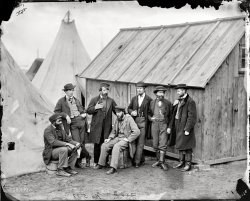
- Sitting Pretty: 1922
- ... life and fauna in the "sea gardens" at Nassau, New Providence, has returned from the Bahamas with a new film, and by invitation, ... Posted by Dave - 07/27/2012 - 12:22pm -
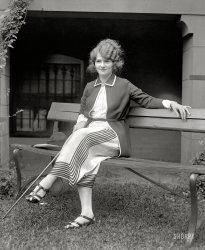
- Pennsylvania 5401
- ... cars. It will make stops at New York City, New Haven and Providence.
Little Miss Eaton, who will christen the train, is the ... Posted by Dave - 04/04/2013 - 3:30am -
![Pennsylvania 5401 July 14, 1929. "New Boston train, 'The Senator,' at Washington's Union Station, departing at 12:30 p.m. The train is to arrive in Boston at 10 p.m., cutting 3½ hours off the time made by the other two Pennsylvania line trains there, the Federal and Colonial expresses." Harris & Ewing glass negative. View full size.
1927 K-4?What a great pic! Is this one of those 1927 K-4's? Help us out PRR friends! Thanks for posting!
Train Christening
Washington Post, July 14, 1929.
New Boston Train to Be Christened
Ten-year-old Ellen Page Eaton will break a bottle of Potomac River water on the locomotive of a new Pennsylvania Railroad train this morning at 11 o'clock in the Union Station and christen it “The Senator.” The train will give the fastest service between Washington and Boston.
After christening, the train will be open to inspection until its time of departure, 12:30 p.m. The train is scheduled to arrive in Boston at 10 p.m., cutting 3½ hours off the time previously made by the other two Pennsylvania line trains to Boston, The Federal and the Colonial expresses.
“The Senator” will be an all-Pullman train with dining, observation and club cars. It will make stops at New York City, New Haven and Providence.
Little Miss Eaton, who will christen the train, is the daughter of John Eaton, crack engineer of the railroad, who is veteran of 28 years. …
Even Faster NowOn Amtrak's Acela Express the trip can be made in 6 hours and 40 minutes.
What's ItOK, what the thingie hanging from the train: an anchor line?
[My guess: part of the bottle-breaking ritual mentioned in Washington Post story. - tterrace]
[It's the bottle holder. - Dave]
Little Miss Eaton...must be the one in the white frilly dress.
PRR 5401A really great photo, notice the PRR emblem on the steam valve cover above the piston.
Lock box?What is the locked box on the front of the engine for?
It's a K-4built in 1927, 92 were built, Baldwin built all locomotives from 5400 to 5474, all other K-4s were built by PRR in the Juanita Juniata shops.
K-4 or K-4s?The "s" suffix in the PRR steam locomotive classification scheme denotes the presence of a superheater. PRR supposedly stopped using the "s" suffix in 1923, as by this time, the superheater was a standard design element. Nonetheless, you commonly see these locomotives referred to as K-4s. The 5401 was indeed built in 1927. Here she is a few years later looking a bit grimier:
Fresh Out of the BoxHere are an engineer and fireman whose garments will never again appear so pristine. In the glorious days of steam, anything forward of the baggage car was filthy work indeed, and even the most assiduous washing resulted merely in progressively more faded coveralls, with coal, smoke, and cinder stains intact.
Re: Lock Box and the K-4Guessing the lock box on the pilot beam contains tools and parts for quick maintenance on the road, stuff like extra lenses for the marker lamps, air and steam heat hose connections, etc, as well as the green and white flags mounted high on the locomotive which would indicate the train is running as a second section or an extra movement. At first I thought it might hold red (emergency stop) flags, fusees, and explosive "torpedoes", which are clipped to a rail and go bang when something runs over them, signaling the engineer for an emergency stop. These items, being needed by the crew quickly in an emergency, would be kept in the cab, as they still are today.
K-4 Pacifics would run on the Pennsy until 1957, but by 1935 the rails between DC and New York were electrified with overhead wires, and steam became a rarity on the line now known as the Northeast Corridor.
Automatic Train ControlThe locked box on the pilot beam is an instrument case for the Union Switch & Signal automatic train control equipment.
Train control?PRR Washington to New York had cab signals in the 1930s. The line has some form of train control now, but probably not in 1929.
Looks like PRR began installing train control (that is, automatic brake application if the engineer ignores a restrictive signal) in 1951. (Railway Age, 12 March 1951 p93 -- it's online at hathitrust.org.)
Cab Signals and Automatic Train ContolThe ICC mandated the introduction of ATC in 1922. PRR's first installation was in 1923 and they made the decision at that time to integrate cab signals with ATC. Harrisburg to Baltimore was equipped for ATC and cab signalling by 1927, and it was extended to Washington not long afterwards.
(The Gallery, D.C., Harris + Ewing, Railroads)](https://www.shorpy.com/files/images/SHORPY_35483a.thumbnail.jpg)
- A Race Set Free: 1906
- ... Group , erected in Park Square in front of the Providence Railroad passenger-station, is by Thomas Ball, and was a gift to the ... Posted by Dave - 09/30/2012 - 8:27am -
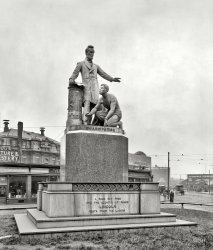
- Pie Town P.O.: 1940
- ... half of its journey, and for that demonstration of divine providence and travelling mercies, can I get an AMEN?!
I will submit an ... Posted by Dave - 08/06/2020 - 6:24pm -
![Pie Town P.O.: 1940 June 1940. "The stage which daily brings in mail, freight, express and passengers to Pie Town, New Mexico." Medium format acetate negative by Russell Lee. View full size.
Pie Town Mail DramaTwo years ago the USPS said they were closing the town's PO building due to it being unsafe and beyond repair. The residents kicked up enough of a fuss, with some high-powered help, that the plan to relocate services to another town 20-ish miles away were scrapped. Pie Town is still on the (postal) map.
ChicksLooks like someone is getting a bunch of chicks to raise in those boxes on the left. We used to get those in my long-ago boyhood and raise them in the “brooder”. The brooder was a feeder that had a light to keep the little ones warm until they got some feathers. First thing you knew, there were eggs to eat and nice fryers to have for Sunday dinner.
Smoke 'Em If You Got 'EmIt's a gas station. What could go wrong?
Straps GaloreThose are some beautiful suitcases strapped on there next to the baby chicks... I would love to own just one! Someone is traveling in style!
The Red, White & Blue of BarnsdallThe globes, decked out in all their color!
Well Carl,I still think we should have bought the truck.
'38 Chrysler RoyalLooks like a 1938 Chrysler Royal sedan from what we can see of it. A very cool pic for sure. I will buy a print of this one.
[The car is a 1937 Plymouth. - Dave]
The Real McCoy!I see Amos McCoy (Walter Brennan) is in town to pick up his load of chicks for the farm.
The Miracle of the Precariously-Piled PortmanteauxI can think of no other reason besides divine interdiction to explain how this Physics 101 nightmare-on-wheels made the 75+ miles from Springerville (or Socorro) to Pie Town, lurching and bouncing and wheezing over winding trails of washboard and ruts, without that precarious pile of portmanteaux bouncing off and scattering to the winds, somewhere outside of Quemado (or Magdalena).
A close look shows a mere wisp of cord (and substantial prayer to the Gravity God) holding the top valise in place. If my father ever saw this load, once he recovered from the resulting angina attack, he would mutter "No! No! No!" and send me to fetch another 100+ft of rope.
Mr. Lee, however, provides proof that the load survived at least half of its journey, and for that demonstration of divine providence and travelling mercies, can I get an AMEN?!
I will submit an application to the Congregation for the Causes of Saints, making the case that Santa Fe Trailways truly deserves the name "SANTA" Fe Trailways.
[Still, I wonder how many of those chicks arrived scrambled. - Dave]
Prince Albert in a can ...... Clabber Girl in a box.
Royal Family"Well let him out!"
ICC Lights and Reflectors Lots going on in the photo. Interesting to see a automobile fitted with Interstate Commence Commission lighting in addition to being rigged out like a stagecoach. Wonder how long these cars lasted in this type of road service.
Like many chicks I have knownThey come with a lot of baggage.
Both Sides MarkedSANTA FE TR___ Truck Lines? Trucking Co.?
[Trailways. - Dave]
Out in the weatherThey certainly seem to count on rain being infrequent in that part of the country.
(The Gallery, Cars, Trucks, Buses, Gas Stations, Pie Town, Russell Lee)](https://www.shorpy.com/files/images/SHORPY-8b25335a.thumbnail.jpg)
- Grand Palace: 1921
- ... I can clearly remember storefronts in downtown Providence, Rhode Island, that were very similar to this as late as the early ... Posted by Dave - 08/06/2012 - 1:57pm -
![Grand Palace: 1921 Washington circa 1921. "Grand Palace shoe shining parlor, 719½ 14th St. N.W." National Photo Company Collection glass negative. View full size.
Deep, dark mysteries I can clearly remember storefronts in downtown Providence, Rhode Island, that were very similar to this as late as the early 1960's. They'd be deep, dark, somewhat run down -- and I'd often see men's faces, far inside, staring back at me when I looked in. Smoke, shoeshine and magazine stores like this were often combined and it was understood that they were for men only, not kids or "nice" women. I suspected that, much deeper, toward the rear, other sorts of magazines, of particular interest to men, were available upon request, but by the time that I became old enough (and courageous enough) to consider venturing inside, they'd all gone the way of the dinosaur.
We Clean Your Hat
Men's MagsAmong others The National Police Gazette, Field and Stream, The Ballplayers' Chronicle, Sporting Life were all being published during this time.
[I'm pretty sure those aren't quite the kind of men's mags Mattie was referring to. - Dave]
The booth in the backSo you took off your suit and sat in a "private booth" while it was pressed? I guess you whiled away the time by reading those magazines of particular interest to men.
[Which in 1921 would have been what, I wonder. National Geographic? - Dave]
Top 10 Grand Palace details10. Spittoon
9. One point perspective
8. Baseball magazine
7. Hat window illustration
6. Lighting inside
5. Light fixtures
4. Shiny shiny shoes
3. Mosaic threshold
2. Uniform, hat on shoeshine
1. Bob Dobbs lookalike upper right
Image is everythingI find it amazing that in a time where access to personal hygiene was somewhat limited, men accorded so much importance to their exterior appearance.
Shoe shine, pressed suit, well formed hat ... even many of the boys working in Hine pictures tried their best to dress like "little men."
Grand Tile entranceOne symbol of permanence is the tile entrance, which looks like it's being guarded by Joe Pesci.
Too bad there aren't more of those places anymore; just a plain, simple building with one mission: keeping the men looking sharp. In my town, the only thing I can think of that comes close to the experience of this place would be a barbershop. Although he won't use the straight razor for shaving, he still uses a hand-held electric scalp massager from 1920.
Eight-pagersIf you had the password or got an OK from somebody known as a customer, "Tijuana bibles" and other "literature" could probably be had under the counter. It certainly worked that way a few years later in most towns.
Dirty SidewalkWhy do you suppose the sidewalk is dirty in front of this place, but clean in from of the Kase cigar store? Perhaps Kase's scrubbed their sidewalk often? Or maybe the shoeshiners were pretty messy and often got polish on the soles of shoes. Or it could be tobacco or cigar tips spit on the sidewalk. Still, these guys never cleaned their sidewalk like the neighbors did.
[There's an easy answer to that question if you look carefully. Or even not so carefully, as long as you look up. - Dave]
So, when it rains, it rains scum instead of water? It's hard to believe that the awning on the right would make a difference of that magnitude, unless the B&W film is deceiving and what looks like dark dirt/scum is really just wet sidewalk.
[Below, the sidewalk the same day before it rained. - Dave]
First impressionsLike the other commenters, I saw this as a men only kind of place - then I noticed the sign offering Altering and Repairs for Ladies & Gents. So, who knows?
(The Gallery, D.C., Natl Photo, Stores & Markets)](https://www.shorpy.com/files/images/30282u0_0.thumbnail.jpg)
- Old Folks at Home: 1935
- ... in Louisiana at Transylvania Plantation just south of Lake Providence, blacks who had lived on the plantation since the Civil War were ... a particularly militant civil rights group based in Lake Providence. It appears that throughout the south the projects set up by the FSA ... Posted by Dave - 07/05/2009 - 2:04am -
![Old Folks at Home: 1935 October 1935. Brown County, Indiana. Prospective Resettlement Administration clients whose property has been optioned by the government. View full size. 35mm nitrate negative by Theodor Jung for the Farm Security Administration.
Resettlement?Can someone decode what the caption means? Resettlement clients? Property optioned? It sounds like their farm dustbowled up and the Roosevelt government is buying them out, but I'd like the official word... Thanks!
[Wikipedia article on the Resettlement Administration. - Dave]
Brown County INBrown County has the largest Indiana state park and part of the Hoosier National Forest. Brown County has by far the highest concentration of forested land of any of Indiana's 92 counties with nearly 90% coverage and almost no large farms at all. I think these people we relocated to help create these great parks.
http://www.fs.fed.us/r9/hoosier/docs/history/history.htm
Resettlement AdministrationThe resettlement of tens of thousands of people occurred through government action in the 1930s. In some cases it was for projects like the Tennessee Valley Authority where vast areas of bottom lands were flooded and the owners of the land, many of them having families that dated to the Revolutionary War period, were "resettled". In other cases, people lived on what the government determined to be submarginal lands and they were bought out and given the option of settling in a "homestead project" such as the ones developed by the FSA and, earlier, the Resettlement Administration. I don't know the particular history of Brown County, Indiana, where clients were "optioned", but it appears to fit that pattern.
However, in Louisiana at Transylvania Plantation just south of Lake Providence, blacks who had lived on the plantation since the Civil War were evicted by the FSA and white farmers were brought onto the land. The only evidence of this is determined by the photographs made by Russell Lee. There is no reliable history, at this point, that tells us exactly what took place and why (except for the photographic evidence). The result of the removal of hundreds of black tenants, their houses turned over to the new arrivals as well as their churches and community center, was an embittered and angry black population. They formed the nucleus of a particularly militant civil rights group based in Lake Providence. It appears that throughout the south the projects set up by the FSA had very long lasting implications.
The government had determined that FSA projects would be segregated, at the instigation of politicians, which was a profoundly different pattern for sharecroppers in particular who lived in racially mixed arrangements on the land. the result, time and again of this "resettlement" in the south was that whites and blacks were separated and concentrated in isolated communities. the black communities were often the font of civil rights work in their region. The white communities such as the Dyess Project in Arkansas were the centers of the Ku Klux Klan.
Here is a website that outlines some of our research:
http://www.siu.edu/%7ejadams/fsa/
(The Gallery, Great Depression, Rural America, Theodor Jung)](https://www.shorpy.com/files/images/8a14048u.thumbnail.jpg)
- Hill House: 1936
- ... when the farm and some of the families resettled nearby at Providence Farms near Lexington, Mississippi.
... Posted by Dave - 09/07/2018 - 11:55am -
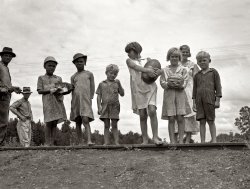
- A Sterling Reputation: 1906
- ... pragmatic Gorham Co. manufactory and offices, located in Providence, provide the perfect complement to this eloquent tastemaker in NYC. ... Posted by Dave - 08/09/2012 - 2:41pm -
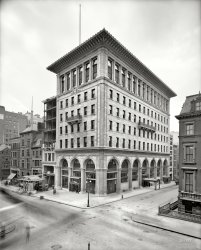
- Shoo's: 1917
- ... Reminds me of similar places I used to see in downtown Providence. Shoomaker's looks a little on the dumpy side, too, but that ... Posted by Dave - 07/19/2012 - 10:17pm -
![Shoo's: 1917 Washington circa 1917. Shoomaker's saloon at 1311 E Street N.W. after having moved from 1331 E Street in late 1914. National Photo Company glass negative. View full size. Thanks to Quondam Washington for the inspiration.
My day planned outI'm going to start with lunch on the left, have my shoes shined and my hat blocked, drop off my laundry, snack on peanuts, stop in at Shoo's for a couple of beers, and then enjoy dinner at the Globe, topped off with cigars.
Wait for meSince I'm a female I need an escort to enter Shoo's establishment. Besides, you sound like very good company. I may be a little late since I must buy a hat.
Shoeshine RatholeI suspect that any 'lady' entering that establishment would no longer be one upon exiting. Reminds me of similar places I used to see in downtown Providence. Shoomaker's looks a little on the dumpy side, too, but that beautiful dome and the eagles over the Globe makes this picture worthwhile. Of course, they're all gone now, right? I'm afraid to look. Lately I've been reminding myself that buildings like these were very probably familiar to Walt Whitman when he lived in DC for ten years in the 1860s and 70s.
Buy a Liberty BondThe Liberty Loan poster in the left window seems to be one designed by a Miss Eugenie De Land. That would narrow the date of the photo to after Oct. 1, 1917.
[Which was the issue date for bonds of the Second Liberty Loan. Alex is today's recipient of the Shorpy Sleuth Merit Badge! - Dave]
1915?There appears to be a sign for "On With the Dance" which came out in 1915. So if the Liberty Bond sign is from 1917, then the movie posters were up in those windows at least two years.
["On With the Dance" was a play being staged at the nearby National Theater in October 1917. - Dave]
Too much to take in at onceA new Shorpy picture of a retail block is always a delight! I try to be as thorough as possible on the first look, but there’s always stuff that only strikes my eye on later viewings.
Right now I’m taken by the fancy electrified façade of the Franklin Laundry. I mean, why would you take your clothes anywhere else?
Imagine the flirting that could take place in a combined Ladies and Gentlemen’s Shoe-Shine Parlor! Oh, the glimpses of delicate, silk-clad ankle a fellow could steal! If he was lucky, and had a nickel in his pocket, he could treat her to some hot peanuts on the way out.
I’m intrigued by the “Established 1858” sign. The “18” looks painted over – must have been for some aesthetic reason, surely?
Watch the birdie!The two gents at left certainly didn't want their faces recorded. Easier to deny to their Missus they were down at Shoomakers. I wonder if they served schooners of beer at Shoomakers?
(The Gallery, D.C., Eateries & Bars, Natl Photo)](https://www.shorpy.com/files/images/32838u.thumbnail.jpg)
- Running Behind: 1963
- ... this photo still exist. (The address of the Saxony was 35 Providence St. - although there is still a street with that name it's really no ... Posted by Dave - 07/18/2015 - 8:24pm -
![Running Behind: 1963 1963. "Cab driver and taxi at Saxony Bar & Lounge, Boston." 35mm negative, photographer unknown. Another eBay find scanned by Shorpy. View full size.
What's He Going For?Based on his near-full immersion, the gearshift linkage or the starter motor.
Poor man's power steering"Necker's knob" on the steering wheel.
1963Back then you could actually fix your own car.
Fancy TaxiThis was a top of the line 1956 Plymouth Belvedere before it became a cab. It even has the optional wire wheel hubcaps. Most taxi companies used a specially equipped stripped down Savoy model with a six cylinder engine.
A Cheap Bike Lockseems to have found a better use as a hood tie-down on this battered Belvedere.
[It's a hood lock now. - Dave]
My dad the cab driver.My dad drove a cab in Boston from 1962 to 1964 so you can imagine that this caught my eye. He was tall and slender so I don't think this is him. Unfortunately he passed away a year ago but oh boy....he would have LOVED this photo. Thanks.
Stick or AutomaticIf it's a stick I would guess he's trying to get the shift levers back in alignment.
Those old "three on the tree" shifters could get worn and jump in between the levers, leaving you stuck in one gear.
[With no shift lever to be seen here, the car had a PowerFlite automatic transmission controlled by pushbuttons on the dash. - Dave]
Park SquareThe Saxony Lounge was located in Park Square, which for many years was the location of the Greyhound/Trailways bus depot and home to a lot of sketchy activity (drug use, prostitution, street theft, you name it). More recent arrivals to Boston will know Park Square as it currently exists - the home of upscale restaurants, office buildings, and fancy hotels - it has undergone a massive transformation in the past 20 years. I don't think either the buildings or the street shown in this photo still exist. (The address of the Saxony was 35 Providence St. - although there is still a street with that name it's really no more than an alley. I think this portion of it was in an area that got reconfigured.)
That darned pushbutton PowerFliteWe had a 1957 Plymouth back in the day. After a visit to the dealer to replace the light bulb behind the buttons, it seems the panel was not properly secured. One good bump on the way home and - off comes the panel, and out pop the buttons? After a couple of tries, I figured which went where and off we went.
Havana-Where one would now need to go to see such a nice variety of late 1950s American autos in everyday urban service.
(The Gallery, Boston, Cars, Trucks, Buses, Found Photos)](https://www.shorpy.com/files/images/SHORPY-BW-009.thumbnail.jpg)
- Brunonian Bricks & Books: 1906
- Providence, Rhode Island, 1906. "Library, Brown University." The building ... on College (Brown and RISD) Hill on the East Side of Providence, and is the current home of the Brown University Economics ... Posted by Dave - 10/29/2019 - 8:35pm -
![Brunonian Bricks & Books: 1906 Providence, Rhode Island, 1906. "Library, Brown University." The building currently known as Robinson Hall. 8x10 inch glass negative, Detroit Publishing Company. View full size.
Ivy Leagueliving up to its name.
Dirt road?Wasn`t expecting to see a dirt road in the nations 20th largest city at that time.
[The street is paved. - Dave]
Nose PowderingSeen here, the Old Girl standing proud and true at the corner of Waterman and Prospect Sts. on the first day of November 2019. Though less ivied, and currently getting a much needed cosmetic touchup (as any gal born in 1878 might), she's long resided on College (Brown and RISD) Hill on the East Side of Providence, and is the current home of the Brown University Economics Department.
(The Gallery, DPC, Education, Schools)](https://www.shorpy.com/files/images/SHORPY-4a13613a.thumbnail.jpg)
- Veronica and Steven: 1912
- ... Wickes Hine.
Lead on these people 1920 census: Providence, Rhode Island 5 Dryden Lane
Josephine Mikula 54 Galicia ... card for Steven M. Mikula shows:
102 Charlstone Ave., Providence, RI
born 27 Aug 1896 Austria
"Always know your address" is ... Posted by Dave - 09/08/2011 - 6:25pm -
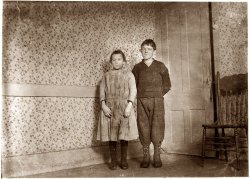
- Loves Olives: 1956
- ... advertising layouts, product packages, etc. Thankfully, providence spared us the simultaneous affliction of women’s sack dresses ... Posted by Dave - 06/14/2012 - 4:59pm -
![Loves Olives: 1956 Southern California circa 1956. One of a dozen Kodachrome slides that I recently found on eBay. If the clothes here were any sharper we'd need to call 911. No T- shirts and jeans for these folks. More to come over the weekend. View full size.
Pink Golden AgeIf this photo was shot in 2012, the young woman's clothing would be far different. The Pink Top would be gone and the Dress would be daringly unbuttoned.
It's been interesting watching Shorpy Photos and seeing the progression of women wearing less and less clothing through the years since the camera was invented. Seems the 1950s was the happy medium.
What were we thinking?I’m guessing the guy on the left is wearing suede shoes. 1955/56 were the years of pink and charcoal attire for men of the world, as were blue suede wingtip shoes. What we can see of him measures up to the standard, so I’m assuming his footwear does also---including the obligatory pink argyle socks. Pastel colors abounded everywhere at the time: car paint, fiberglass boats, interior décor, furniture, home exteriors, advertising layouts, product packages, etc. Thankfully, providence spared us the simultaneous affliction of women’s sack dresses during the same period, as they were still a couple of years off.
"Mad Men," eat your hearts out!Why does the song "Sharp Dressed Man" come to mind? Seriously, the clothes are wonderful!
Green olive loverThat's a really cute girl! I'm wondering what the story is about the b&w photo of the white couple. Maybe Olive Girl is biracial and those are her grandparents. I'm speaking this as a mother with two biracial kids and three biracial grandkids, as of yesterday (baby boy, 7lbs 6oz)!
UnforgettableHaving been a fan of Nat King Cole, I attended some of his concerts in the early '60s. He dressed so very similar to these two men, very elegant, slender, meticulously groomed and a very smoooooth operator. As soon as I saw this picture, I was reminded of his demeanor. He was especially graceful and attentive to his fans and yet was so humble and congenial to all and his voice was one in a trillion, never to be duplicated. Even though these two do not really look alike, they both interpreted his sophisticated "style" beautifully.
What my sons would say"If you could get ALL those olives in the dish into your mouth at the same time, I'll give you a quarter." This was the kind of stunts they'd pull in their teen years and beyond. Their youngest brother at age 5 had a near tragedy trying to fit a whole wedge of cantaloupe in his mouth at once. Thank goodness Mom intervened.
Great Photo findThere are still many of us around from that age and that time. Dave, I hope you can get some names to attach to the pictures. I'm looking forward to the next of the set.
[Alas, the only name on these slides is "Kodachrome." -Dave]
B&W PhotoI don't think the couple in the photo are white noelani. I think the woman is just lighter skinned.
(SoCal 1956 Kodachromes)](https://www.shorpy.com/files/images/SHORPY_Olive_Party.thumbnail.jpg)
- American Gothic: 1923
- ...
Next door I saw some great examples of this style in Providence, RI, recently, but I am partial to the austere balance and symmetry ... Posted by Dave - 08/06/2012 - 1:57pm -
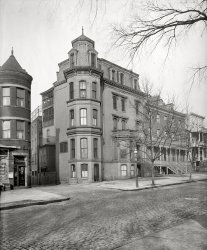
- Desk Lamp: 1938
- ... of Standards optics metrology branch, died Nov. 20 at Providence Hospital after a heart attack. He lived in Washington.
Mr. ... Posted by Dave - 07/23/2012 - 10:53am -
![Desk Lamp: 1938 March 21, 1938. Washington, D.C. "Purchasing on an average of 4 million electric light bulbs annually, Uncle Sam is probably one of the largest users of light in the country. The National Bureau of Standards sees that the government gets value received in purchases by continually testing the incandescent lamps to determine their life and the amount of light they give. Using a special machine designed by the Bureau, Louis Barbrow is shown measuring the amount of light given by a lamp." Harris & Ewing Collection glass negative. View full size.
Lumen Counter
Obituaries, Washington Post, Nov 24, 1986
Louis E. Barbrow
81, a retired chief of the National Bureau of Standards optics metrology branch, died Nov. 20 at Providence Hospital after a heart attack. He lived in Washington.
Mr. Barbrow was born in Pittsburgh. He earned a degree in physics from Carnegie Institute of Technology in 1926. He moved to the Washington area in 1927 and joined the NBS, where he specialized in measurement [of] radiation, light and color.
He had served as chief of the photometry and colorimetry section and was chief of optics and metrology when he retired in 1969. In 1967, he was secretary of the U.S. delegation to the International Conference on Illumination.
Since retiring, he had been a consultant to the NBS Office of Weights and Measures.
Mr. Barbrow was a Mason, a past chairman of the American National Standards Committee, a past secretary of the metric practice committee of the American National Metric Council, and a member of the metric advisory committee of the Society of Automotive Engineering.
Survivors include his wife, the former Blanche Wallace of Washington, a daughter, Jane Lobl of Pittsburgh, and three grandchildren.
A shocking experienceJudging by all the bare wires and exposed splices, one could have an enlightening experience even without a light bulb.
The dark sphere reminds me of the sci-fi movie The Fly.
Idea ManThis guy obviously has many good ideas just waiting to be developed for cartoon characters.
IntegrationThe 'ball' is an Integrating Sphere, used to measure the various characteristics of light sources, especially 'power output' - luminous intensity, etc.
The device is painted inside with very carefully controlled reflective paint, and the optical radiation (infra-red, visible, or ultra-violet) from a test lamp can be measured with photocells, etc., without regard to what portion of, and what direction, the energy is coming from.
If you wished to measure the water flow from a lawn sprinkler, but only had a small cup to use, the measurement would be very inaccurate because only the streams coming toward you would go in the cup, the rest would be 'lost' on the lawn. So you'd have to move around the entire spray pattern in a known and timed manner, take lots of small measurements, and factor all that in, -OR- you could just put the whole sprinkler in a closed box with a single drain, and do your flow measurements using that.
The integrating sphere does this for light sources, it 'collects' (integrates) the output in a known and controlled way, and eliminates directional errors.
http://en.wikipedia.org/wiki/Integrating_sphere
Although primarily an electronics engineer, I have done some work with illumination systems, and still have the small sphere I bought surplus years ago on my shelves, along with the other piles of "stuff".
As for the exposed knife switches and variable resistors (the long round tubes with sliding knobs on the top) - yeah, that was pretty dangerous - and all the circuits were two-wire, no real grounds from the mains... you had to be careful and pay attention or your gear taught you a lesson. :)
Henceforth... the $45 light bulb!
(Technology, The Gallery, D.C., Harris + Ewing)](https://www.shorpy.com/files/images/24279a.thumbnail.jpg)
- Great-Aunts
- ... though!
Klingele? Gee - I work for The Sisters of Providence in Everett, WA. The Sister Representative on our executive council ... Posted by kevhum - 10/12/2007 - 11:58am -
- Deluxe Depot: 1941
- ... demise.
My Birthplace Yup. Born at the old Providence Hospital on RT.5 in 1962. I go to Holyoke for work all the time.
... Posted by Dave - 06/20/2016 - 9:45pm -
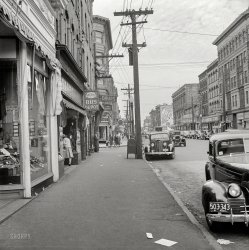
- Buffalobelisk: 1911
- ...
Bryant & Stratton Business College In Providence RI they even had their own bank and money!
Not on the spot ... Posted by Dave - 10/20/2017 - 10:22am -
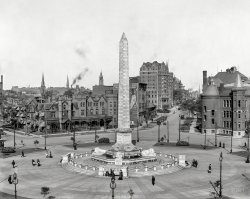
- Shamrock: 1934
- ... weeks, thinking it was Pemberton’s headquarters, but Providence held a protecting hand over and about the beautiful home, and but ... Posted by Dave - 03/17/2014 - 12:28pm -
